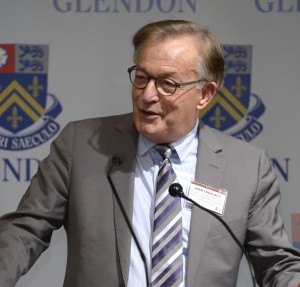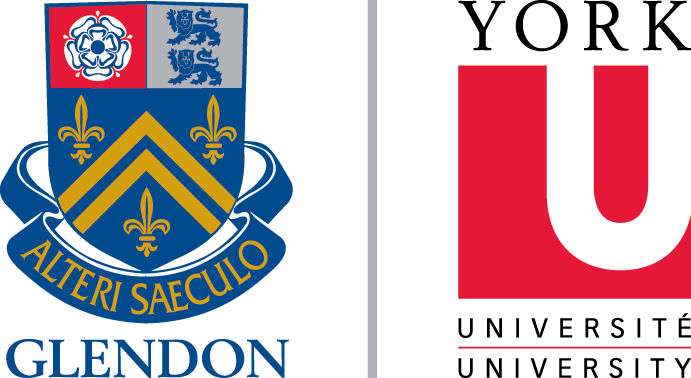
Jean-Louis Roy, Président de Partenariat international
Jean-Louis Roy at Glendon at the inaugural conference of the 50th anniversary celebration of York University’s bilingual campus.
Fifteen years after the establishment of the Québec Studies Chair at York University’s Glendon campus, Québec and Ontario acknowledged their status as the “hard core” of Canadian federation. Starting under Jean Charest and Dalton McGuinty, and continuing under Philippe Couillard and Kathleen Wynne, these two large provinces have now formalized their political and economic co-operation through numerous meetings and agreements.
Jean-Louis Roy was one of the Chair’s creators as well as Editor-in-Chief of Le Devoir; he was also Québec’s delegate to Paris and the Secretary General of la francophonie before settling in Toronto in 2000. According to him, the results of the latest federal elections seem to contradict the theory – propounded notably by Globe and Mail analyst John Ibbitson – that the centre of Canadian power is moving inexorably to the western part of the country.
Mr. Roy shared these thoughts on December 3, 2015, at a seminar on Ontario-Québec relations that launched the activities planned for Glendon College’s 50th anniversary in 2016.
Ontario and Québec: Neighbours living in mutual ignorance
Mr. Roy responded positively to the appeal from Kenneth McRoberts, former Glendon Principal, to fill the void left by a dearth of “forums for political dialogue between Québec and Ontario” and even fewer Ontario writings about Québec and vice versa.
Moreover, Mr. Roy published an essay in 2013 entitled Chers voisins (Dear Neighbours) in which he explained Ontario to Quebeckers.
After living in Paris for 20 years, he also feels that “the Toronto I rediscovered in 2000” was everything that Paris was not. Both actually and virtually, Toronto is a conglomerate of minorities or communities that does not invalidate shared citizenship.”
In France, on the contrary, “diversity is carefully limited. Let’s say that multiculturalism is not as highly valued there and that communitarianism is seen as something that goes against shared citizenship.” This might be due to the fact that “Paris already has a full rich history” while Toronto is still looking for its place in history” (to paraphrase Lisa Rochon of the Globe and Mail.)
A lot on our plate
The rapprochement between Ontario and Québec provides the holder of Glendon’s Québec Studies Chair with a multitude of topics to reflect on and write about for a number of years to come, according to its first occupant.
Mr. Roy pointed out that, in 2009, Ontario and Québec announced that they had lifted various barriers and would harmonize their future regulations in all areas, and that they would offer reciprocal access to their public markets and various spheres of scientific co-operation.
The most obvious aspect of this rapprochement is seen in the annual joint meetings between the Ontario and Québec Councils of Ministers (interrupted by the short-lived PQ minority government headed by Pauline Marois), and in business forums and civil society organizations in both provinces.
In the summer of 2014, the Couillard and Wynne governments undertook to re-energize relations between the two provinces by identifying priority areas of dialogue and convergence: economic and commercial activity, an interest in climate change, infrastructure, and energy supply.
La francophonie
Both governments have even signed a joint declaration on the Canadian francophonie. “This declaration illustrates the major role that Ontario has within la francophonie,” said Mr. Roy.
Moreover, the predecessor of Abdou Diouf and Michaëlle Jean has already stated that Ontario “does more to promote the French language than a number of member countries in the International Organization of la francophonie!”
“I continue to hold this view,” he said at Glendon. “The situation of francophone minorities has improved in recent years, and it is very likely that francophone Quebeckers are now leaving behind their unfortunate divisive attitude towards these minorities. No doubt a few sentimental souls will continue to cling to old beliefs that are now outdated, but I think that the majority of people accept the idea that we are essential to one another.”
* * *
THE FRANCO-GERMAN MODEL
How can we ensure the sustainability of the policy of reciprocal recognition and co-operation put forward by the two pillars of Canadian federation, Québec and Ontario? Jean-Louis Roy sees a possible answer based on the model that unites the two pillars of the European Union, France and Germany.
Extending the existing institutional machinery could, among other things, lead to federation in the following areas:
– potential mechanisms for the alternation of certain large-scale cultural events between Montreal and Toronto for;
– a certain number of Télé Québec-TF0 co-productions;
– an initiative to carve out a place in the world circuit of digital culture;
– a pooling of useful selected digitized educational materials;
– the actions of an Office for Québec-Ontario Youth, with the objective of promoting the greatest possible mobility of young people between the two provinces;
– a teacher mobility program;
– a Québec-Ontario Chamber of Commerce, with events alternating between Ontario and Québec;
– a Québec-Ontario economic forecast institute.
Other Ontario-Québec challenges, as seen by Jean-Louis Roy:
– social policy funding in the coming decades, including old-age security policies;
– changes in federal transfers to the provinces in order to reinforce the delivery of comparable services to all Canadians;
– water management, given that Ontario and Québec share one of the largest fresh water systems on the planet, i.e., the Great Lakes and the Saint Lawrence River;
– the development of clusters of businesses to join international production chains that are, for the most part, centred in Asia;
– the huge reform efforts of international institutions and international standards, including human rights.
By François Bergeron, published in l’Express de Toronto week of January 12-18, 2016


